A COMPARISON BETWEEN TWO CONTINENTS :
LATIN AMERICA AND EUROPE
Tables and graphs
Demography |
Latin
America |
Europe |
Population
(millions of inhabitants) |
354 |
728 |
Population
growth |
1.3 |
0.2 |
Life
expectancy at birth (in years) |
Man
: 67 Woman : 72 |
More
than 75 |
Number
of children by woman |
2.5 |
1.4 |
Infant
mortality rate |
4
% |
1
% |
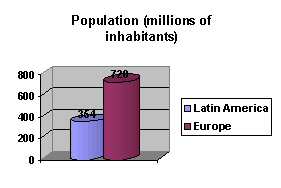


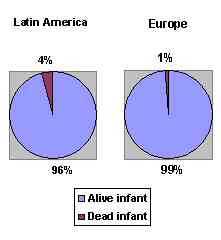
Economy |
Latin
America |
Europe |
PNB/inhabitants
($) |
7070 |
16
150 |
Television
(out of 100 inhabitants) |
223 |
567 |
Phone
(out of 100 inhabitants) |
10.3 |
55.6 |
Unemployment
rate (in 1998) |
20
% |
8.7
% |
Performing
economic sectors |
Oil,
Mineral resource, Chemistry |
Manufactured
metal,Agriculture |
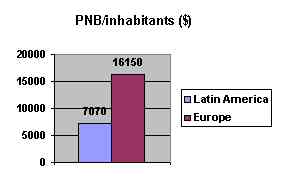
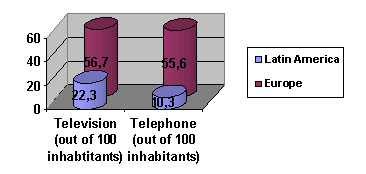

Social
and cultural |
Latin
America |
Europe |
| Active women (in percentage) | 34 |
46.3 |
| Alphabetization rate | 88
% (Uruguay:96%) (Honduras : 21 %) |
98
% |
| Schooling rate | 95
% |
98
% |
| Internet users | 5.2
% |
29.2
% |
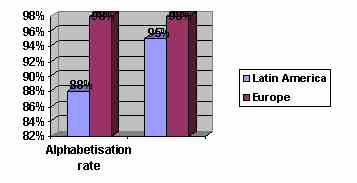
Politic
and human rights |
Latin
America |
Europe |
| Women elected head of state ( in XX c.) | 3
|
1 |
| Number of politic troubles with dictatorial tendency (in XX c.) | 10 |
3 |
| Government’s spend for the education (in 2000) | 4.1
% |
5.2
% |
| Homicide (out of 100 000 people) | 11
|
1 |
| Percentage of Republics | 81
% |
75
% |
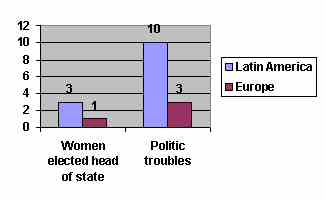
Geography |
Latin
America |
Europe |
| Density (inhabitants/km²) | 17
|
114 |
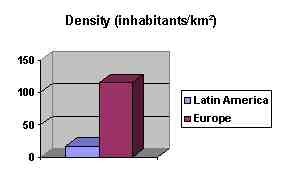
SIMILITUDES |
DIFFERENCES |
| Schooling rate | Population |
| Government’s spend for the education | Population growth |
| Life expectancy at birth | |
| Number of children by woman | |
| Infant mortality rate | |
| PNB/inhabitants | |
| Television | |
| Phone | |
| Unemployment rate | |
| Performing economic sectors | |
| Active women | |
| Alphabetization rate | |
| Internet users | |
| Women elected head of state (in XX c.) | |
| Number of politic troubles with dictatorial tendency (in XX c.) | |
| Homicide | |
| Percentage of Republics | |
| Density |
Analyses
We can note that our continental comparison, between Latin America and Europe, has got a lot of differences and a few resemblances in all the different sectors.
The similitude
concern the Education, indeed the schooling rate and the government’s
spend for the education are relatively similar for the two continents.
Thus, the proportion of children who go to school in Europe is higher
by only 3 points than the proportion of children who go to school in Latin
America.
In Europe, there is an over proportion of the government’s spend
for the education by 1.1 point comparatively to the government’s
spend for the education in Latin America.
In our opinion, that’s a good sign for Latin Americans’ future,
because we could expect that the new generation will have better qualifications
and then increase Latin America’s place in the international market.
It’s
obvious that Latin America and Europe are really different. Indeed,
- On average, in Latin America, there are 97 inhabitants less per square
kilometers than in Europe.
- There are more of two times more inhabitants in Europe than in Latin
America.
- Even if the two population growth are very low, the Latin America’s
one is higher by 1.1 than the Europe’s one, so we can expect that,
progressively, Latin America’s population will overtake ours.
- The European women live more of three years more than the Latin American
women.
The European men live more of eight years more than the Latin American
men.
We can deduce that European living conditions are better than Latin American
living conditions.
- On average,
the Latin American women have 1.1 child(ren) more than European women.
- There is an over proportion of dead infant in the infant population
by 3 points in Latin America, comparatively to the proportion of dead
infant in Europe. It must mean an other time that European living conditions
are better.
- In Latin America, the inhabitants have two times less PNB than European.
It could imply that Latin Americans have less money than so their living
conditions are worse than Europeans’ one.
- We can observe that Europeans have more television and telephones than
Latin Americans, it shows that Latin America’s society is less consumer
and that probably Latin Americans have less money.
- In Latin America, the unemployed are over represented by 11.3 points
comparatively to the unemployed in Europe. It could signify that their
economy is in worse conditions than ours.
- The Latin American women are under represented by 12.43 points in the
active population comparatively to the European women in the active population.
But, in Latin America, 3 women were head of state versus only 1 in Europe
(so three times more). We can’t really explain it, maybe when a
woman has a child she generally stops working and doesn’t work until
her child is older, or maybe this paradox can be explain by the fact that
there are lots of differences between the countries of Latin America,
so some countries might be very liberal for women whereas in some others
there could be lots of prejudices against women.
- On average, there are nearly as Latin Americans as Europeans who know
how to read. But, in Latin America, in some countries there is a majority
of illiterate and in some others there are just a little (i.e. : in Honduras,
out of 100 people there are 79 illiterates whereas in Uruguay out of 100
people there are only 4 illiterates).
- During the XX c., there have been 7 politic troubles more in Latin America
than in Europe. We can infer that the governments are less stable in Latin
America than in Europe.
- In Latin America, there are 6 points more Republics than in Europe.
But as we saw it just before there are more politic troubles so these
Republics could be only a façade.
- In Latin America, out of 100 000 people, there are 10 homicides more
than in Europe. We come to the conclusion that their society is less structured
and that their living conditions are worse than ours.
The fact that our living conditions are better than the Latin Americans’ one is clearly shown up. Nowadays there are lots of differences between Europeans and Latin Americans. It seems that Latin American is processing.
Sources of the tables
- www.eurolatino.com
- www2.unesco.org
- www.quid.com
- www.cia.gov/cia/publications/factbook/docs/notesanddefs.html
- www.focusintl.com
- www.insee.org
Copyright © 2004 Atoussa B. and Camille B. All rights reserved.
